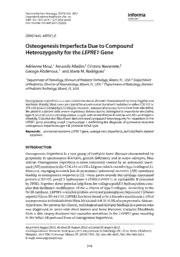
Osteogenesis Imperfecta Due to Compound Heterozygosity for the LEPRE1 Gene. PDF
Preview Osteogenesis Imperfecta Due to Compound Heterozygosity for the LEPRE1 Gene.
FetalandPediatricPathology,32:319–325, 2013 Copyright(cid:2)C InformaHealthcareUSA,Inc. ISSN:1551-3815print/1551-3823online DOI:10.3109/15513815.2012.754528 ORIGINAL ARTICLE Osteogenesis Imperfecta Due to Compound Heterozygosity for the LEPRE1 Gene AdrienneMoul,1 AmandaAlladin,2 CristinaNavarrete,2 GeorgeAbdenour,3 andMariaM.Rodriguez1 1DepartmentofPathology,DivisionofPediatricPathology,Miami,FL,USA;2Department ofPediatrics,DivisionofNeonatology,Miami,FL,USA;3DepartmentofRadiology,Division ofPediatricRadiology,Miami,FL,USA Osteogenesisimperfectaisarareconnectivetissuedisordercharacterizedbybonefragilityand lowbonedensity.MostcasesarecausedbyanautosomaldominantmutationineitherCOL1A1or COL1A2geneencodingtypeIcollagen.However,autosomalrecessiveformshavebeenidentified. Wepresentapatientwithsevererespiratorydistressduetoosteogenesisimperfectasimulating typeII,borntoanon-consanguineouscouplewithmixedAfrican-AmericanandAfrican-Hispanic ethnicity.Culturedskinfibroblastsdemonstratedcompoundheterozygosityformutationsinthe LEPRE1geneencodingprolyl3-hydroxylase1confirmingthediagnosisofautosomalrecessive osteogenesisimperfectatypeVIII,perinatallethaltype. Keywords: autosomalrecessive,LEPRE1gene,osteogenesisimperfecta,perinatalform,skeletal dysplasia INTRODUCTION Osteogenesisimperfectaisararegroupofheritablebonediseasescharacterizedby propensitytospontaneousfractures,growthdeficiencyandinsomesubtypes,blue sclerae.Osteogenesisimperfectaismorecommonlycausedbyanautosomaldomi- nant(AD)mutationintheCOL1A1orCOL1A2gene,whichencodestypeIcollagen(1). However,emergingresearchhasdemonstratedautosomalrecessive(AR)mutations leadingtoosteogenesisimperfecta(2).Thesegenesencodethecartilage-associated protein (CRTAP), prolyl 3 hydroxylase 1 (P3H1/LEPRE1) or cyclophilin B (encoded byPPIB).Together,theseproteinshelpformthecollagenprolyl3-hydroxylationcom- plexthatfacilitatesmodificationoftheα chainsoftypeIcollagen.Accordingtothe NCBIdatabase,LEPRE1isleucineproline-enrichedproteoglycan(leprecan)1[Homo sapiens](GeneID:64175).LEPRE1hasbeenfoundtobeafoundermutationin1.5%of asymptomaticindividualsfromWestAfricaandin0.31–0.5%ofasymptomaticAfrican- Americans.Wepresenttheclinical,radiologicalandautopsyfindingsinapatientwho was diagnosed in utero with short femora and bone fractures. Cultured fibroblasts fromaskinbiopsydisclosedtwocausativemutationsintheLEPRE1generesulting inthelethalARperinatalformofosteogenesisimperfecta. Received6August2012;Revised26August2012;accepted28August2012. Correspondence:MariaM.Rodriguez,MD,DepartmentofPathology-HC-2142,HoltzChildren’s Hospital,1611NW12Avenue,Miami,FL33136,USA.Tel:305–585-6637;Fax:305–585-5311. E-mail:[email protected] A.Mouletal. CLINICALHISTORY The patient is the result of a first pregnancy to a non-consanguineous couple. The mother is of African-Colombian descent and the father is of African-American descent.Therewasgoodprenatalcareandroutinelaboratoryscreenswereallnega- tive;however,theantenatalscreeningultrasoundstudyat18weeksgestationrevealed shortfemora.Detailedultrasoundstudiesat25and35weeksgestationshowedshort extremities with bowing of the long bones including the radii, ulnae and femora as well as fractures of the femora. Other abnormalities included polyhydramnios, breechpresentationandintrauterinegrowthrestriction.Theparentshaddeclinedan amniocentesis. At 35 weeks gestation, the mother presented with preterm labor. Due to breech positioning and previous noted abnormalities, the female infant was delivered by emergencyCesareansection.APGAR(activity,pulse,grimace,appearance&respira- tion)scoreswere2,6and7at1,5and10minoflife,respectively.Respiratorydistress was evident soon after delivery and was managed by nasal continuous positive airwaypressure(NCPAP)ventilationintheneonatalintensivecareunit.Examination revealed a generally hypotonic and edematous infant with respiratory distress and shortlimbsinvarusdeformity.Scleraewerenotedtobewhite.Thebirthweightwas between3rdand10thpercentile,headcircumferencejustabove10thpercentileand lengthgrosslybelow3rdpercentileforgestationalage.Initialradiographs(Figure1) showeddiffuseosteopeniawithmultiplebilateralhealingfracturesoftheseventhand eighth ribs (arrows). There was symmetrical shortening of the humeri, radii, ulnae, femora, tibiae and fibulae and widening of the metaphyseal segments of all long bones.Healingfracturesoftherightproximalhumerusandbothfemorawerenoted alongwithlateralbowingofthetibiaeandfibulae.Differentialdiagnosesatthistime includedsevere,perinatalosteogenesisimperfectaorcampomelicdysplasia. Early consultation with genetics, endocrinology and orthopedic specialties were pursuedandtheconsensuswasmadeforgentlehandling,nocastingandprovision ofadequateanalgesia,chromosomalanalysisandcollagenmutationtesting.Byday7 oflife,theinfantwasweanedoffNCPAPandoxygensupplementationandwastolerat- ingenteralfeedsadministeredviaanorogastrictube.Sherequiredminimalmorphine dosing.Inthesucceedingweeks,theinfantexperiencedprogressiverespiratorydeteri- oration.Shewasfirstnotedtobedesaturatingfrequentlywhenhandleddespitepread- ministrationandincreaseddosingofmorphine.Shethenhadtobere-placedonsup- plementaloxygenvianasalcannulaonday14oflife.Chestradiographsdidnotshow anysignificantparenchymalabnormalitiesalthoughlungexpansionseemedconsis- tentlypoor.Therewasgraduallyincreasinginspiratoryoxygenfraction(FiO2)require- mentoverthefollowingweekrequiringre-placementonNCPAPventilation.Onday 29oflife,shewentintosevererespiratoryfailurerequiringmechanicalventilationus- ingahigh-frequencyoscillatoryventilator(HFOV).AC-reactiveproteinwaselevated at2.8mg/dLwitharelativeneutropenia(WBC4900/mm3)andincreasedbandsof 23%.Empiricantibiotictreatmentwasinitiatedafterbloodandurineculturespeci- menswereobtained.Lumbarpuncturewasdeferredduetotheincreasedriskofin- ducingfractures.EnterococcusfaecaliswasisolatedinthebloodcultureandKlebsiella pneumoniaewasisolatedfromtheendotrachealtubeculture.Antibiotictherapywas adjustedandcontinuedfor21daystocoverforthepossibilityofmeningitis.Inthe meantime,karyotypestudieswerereportedasnormal. Byday36oflife,aweekafterbeingonmechanicalventilation,therewasnoclinical improvement.TheinfantcontinuedwithCO2retentionandborderlineoxygensatu- rationsdespitemaximalsettingsontheHFOVandanFiO2of1.0.Amultidisciplinary meetingwasheld,includingthepalliativecareteam,socialworker,neonatologyand FetalandPediatricPathology OsteogenesisImperfectaandLEPRE1Gene Figure1. Composite photographs of her skeletal survey. (A) Chest radiograph on day 1 of life demonstratingdemineralizationofthebonesandmultiplehealingribfractures,includingtwoeach intherightandleftseventhandeighthribs(arrows).(B)Frontalviewoftheupperpartofthebody depictingshorteninganddemineralizationoflongbones,morerecentfracturesofbothproximal humeri.(C)Frontalviewofthelowerlimbsdemonstratingdemineralizationwithshorteningand bowingofallofthelongbones.Themetaphysesalsoappearwidened.Therearehealingfractures ofthemid-shaftsofbothfemoraandbothproximaltibiae.(D)Lateralviewoftherightfemurat 10daysofageshowingmorefracturesasevidencedbyincreasingareasofcallusformation. the patient’s family. It was determined that if needed, chest compressions may be ineffective, detrimental and painful for the infant given her propensity for frac- tures. Respiratory support would continue but the patient would not receive es- calation of care with vasopressors and cardiopulmonary resuscitation (CPR) if needed. Onday48oflife,theinfantwasreplacedonaconventionalventilatorathighset- tings and switched to continuous fentanyl infusion for pain management. The re- sultsofDNAsequencingforCOL1A1andCOL1A2mutationsinthepatient’speriph- eralbloodwerereportedasnegativeandaskinbiopsyforfurtheranalysiswasper- formed. She continued with frequent and deep desaturations and as per previous discussionwiththefamily,intheeventofbradycardia,resuscitationwastobelim- itedtoonedoseofintravenousepinephrine.Onday54oflife,thepatientdeveloped bradycardia, which did not respond to intravenous epinephrine, and expired. The parentswereinformedoftheevents,counseledbythestaffandgaveconsentforan autopsy. Copyright(cid:2)C InformaHealthcareUSA,Inc. A.Mouletal. Figure2. Thepatient’sposteriorviewatautopsydemonstratingshortandbowedupperandlower extremities.Noticeredundantskinthatseemsexcessiveforthebonelength. AUTOPSYREPORT Theautopsydemonstratedthebodyofafemalechildwithmultipleskeletaldysplas- ticfeatures,measuring31.5cmfromcrowntorump,12.5cmfromrumptoheeland weighing3826g.Therewasshorteningandbowingoftheupperandlowerextrem- ities(Figure2),withbothlowerextremitieshavingavarusdeformity.Thechestcir- cumferencewas38.5cmandthatoftheabdomenwas33.5cm.Periorbitaledemawas present.Thescleraewerewhite.Thesofttissuesofthescalpwereedematousresulting inacephaliccircumferenceof36cm(normal:31.5cm).Theoccipitalregionwasflat. Theanteriorfontanellewaslarge,measuring4.5×4cm.Theposteriorfontanellewas 3×2cm. Internal examination revealed pleural petechiae bilaterally. The lungs were con- gestedandatelectatic.Therewasa2.2×1.7×1.7cmcysticmasswithserousfluid locatedononeovaryandasimilarcystlocatedontheotherovary,measuring1.2× 0.8×0.8cm.Thecranialposteriorfossawassmall. Microscopic examination of the ribs (Figure 3) demonstrated an irregular cos- tochondral junction, thinning bony trabeculae and callous formation at the site of a healing fracture. The vertebral column disclosed a compressed vertebral FetalandPediatricPathology OsteogenesisImperfectaandLEPRE1Gene Figure3. Compositephotomicrographofbonehistology.Allslideswerestainedwithhematoxylin andeosin.Internalscaleof200mattheleftlowercorners.(A)Age-matchedcontrolofcostochon- draljunctiondemonstratingawell-demarcatedstraightlinebetweenthecartilagetotherightand thebonetotheleft.Theboneisproperlymineralized.(B)Ourpatient’scostochondraljunctionde- pictinganirregulardemarcationbetweenboneandcartilage.(C)Age-matchedcontrol-vertebral body.Noticethenormalbonetrabeculaeandbonemarrow.Thevertebralbodyoccupiesalmost theentirefieldofview,leavingaminimalportionofcartilage(intervertebraldisc)totheleft.(D) Compressedvertebralbodyfromourpatient(allthephotographsweretakenwiththe4×lens). Depictsabnormallymineralizedbonetrabeculaeandbonemarrowfibrosis.Therearetwoportions ofintervertebraldiscsonbothsides. body with expansion of the intervertebral disc as well as callous formation and thinning bony trabeculae. The liver showed centrilobular and sinusoidal con- gestion, microvesicular steatosis and hepatocellular atrophy. The lungs had col- lapsed parenchyma with congestion, numerous desquamated pneumocytes with intra-alveolar hemosiderin-laden macrophages, and patchy hyaline membranes. Therewasmucusandneutrophilslocatedinthebronchiandbronchioliindicativeof acutebronchopneumonia.Theovariescontainedmultiplefollicularcysts. FibroblastculturefromaskinbiopsywassenttotheCollagenDiagnosticLabora- toryattheUniversityofWashington,Seattle.Theirreportindicatedheterozygosityfor twocausativemutationsintheLEPRE1gene,thegenethatencodesP3H1,confirm- ingthediagnosisofperinatallethalosteogenesisimperfecta.Noabnormalitieswere foundinthegenesequencinganalysisofCOL1A1andCOL1A2,CRTAPorPPIBgenes. DISCUSSION Osteogenesisimperfectaisararegroupofconnectivetissuedisordersthatincreasethe patient’ssusceptibilitytomultiplebonefractures.Asagroup,ithasaprevalenceofap- proximately1inevery20000births(3).Therearecurrently11well-definedsubtypesof Copyright(cid:2)C InformaHealthcareUSA,Inc. A.Mouletal. osteogenesisimperfecta,mainlybeingseparatedbytheirgeneticmutationandclini- calpresentation.TypesI–IVaretheclassicalSillencetypesandareallADwithdefects ineithertheCOL1A1orCOL1A2genes.TypeV,whichhasadistinctivehistologybut unknownetiology,isalsoAD.TypeVIisARandisphenotypicallycharacterizedby amineralizationdefectanddistinctivehistology.TypesVII–IXareARandaredueto 3-hydroxylationdefects,whiletypesXandXIarealsoAR,butaresecondarytochap- eronedefects(4). Underthenewclassification,ourpatientisclassifiedashavingosteogenesisim- perfectatypeVIII.ThisistheperinatalseveretolethalformduetoanARmutationin theLEPRE1gene,whichencodesP3H1.TheP3H1,alongwithCRTAPandcyclophilin B(CyPB),formtheprolyl3-hydroxylasecomplexintheendoplasmicreticulum.This complexisapartofthepost-translationalmodificationsystemoftypeIcollagen(5). Therearecurrently17knownmutationsoftheLEPRE1allele,occurringthroughout the gene (6). Our patient had two causative mutations, presumptively on different alleles. AverysmallproportionofMid-AtlanticAfrican-Americans(0.4%)areestimatedto becarriersoftheLEPRE1mutation,resultinginrecessiveosteogenesisimperfectain anestimated1/260,000birthsinthatpopulation.Itisbelievedthatthecarrierswere broughttotheUnitedStatesduringtheslavetrade,asanestimated1.5%ofGhanians andNigeriansarecarriers(7).Theparent’sofourpatientarebothofAfricandescent, withthemotherbeingofAfrican-HispanicdescentandthefatherofAfrican-American descent. Thispatient’sphenotypediffersfromtheclassicalsevereADperinatalformofos- teogenesisimperfecta(typeII)becauseeventhoughourpatienthadintrauterinefrac- tures, bone deformities and slight macrocephaly (spuriously increased because of scalpedema),shedidnothavebluesclerae,andshesurvivedfor7weeksintheneona- tal intensive care unit. A phenotype similar to our patient has been previously de- scribedintypeVIIIosteogenesisimperfecta.Themajorityofthepatientspresentwith rhizomeliaandfracturesinthelongbonesandribcage.Theheadcircumferenceis usuallynormal,buttheskullispoorlymineralizedwithenlargedfontanelle.Thescle- raearealsoeitherwhiteorlightgray(6). Themodeofinheritanceneedstobeaddressedforpropergeneticcounseling,as theperinatalsevereformstendtobede novomutationswithoutriskofrecurrence; however,insevereARinheritancetheparentsmustbeinformedaboutthe25%riskof recurrenceineverysubsequentpregnancy. Whilebisphosphonates,physicaltherapyandorthopedicsurgeryaremainstaysin thetreatmentoftheothertypesofosteogenesis,thereiscurrentlynoeffectivetreat- ment in patients with the perinatal lethal type. However, there are trials, mainly in animalmodels,thatusepharmacologictargetingofstemcellstoinduceosteoblas- ticdifferentiation(8)andthereishopethatthefuturegenerationsofaffectedinfants maybenefitfrompharmacogenomics. Declarationofinterest Theauthorsreportnoconflictsofinterest.Theauthorsaloneareresponsibleforthe contentandwritingofthearticle. REFERENCES [1] SykesB,OgilvieD,WordsworthP,etal.Consistentlinkageofdominantlyinheritedosteogenesisim- perfectatothetypeIcollagenloci:COL1A1andCOL1A2.AmJHumGenet1990;46:293–307. [2] CabralWA,ChangW,BarnesAM,etal.Prolyl3-hydroxylase1deficiencycausesarecessivemetabolic bonedisorderresemblinglethal/severeosteogenesisimperfecta.NatGenet2007;39:359–365. FetalandPediatricPathology OsteogenesisImperfectaandLEPRE1Gene [3] MariniJC.Osteogenesisimperfecta.In:BehrmanRE,KliegmanRM,JensenRM,editors.Nelsontext- bookofpediatrics,Philadelphia,PA:Saunders;2011.pp2437–2440. [4] ForlinoA,CabralWA,BarnesAM,MariniJC.Newperspectivesonosteogenesisimperfecta.NatRev Endocrinol2011;7:540–557. [5] MariniJC,CabralWA,BarnesAM,ChangW.Componentsofthecollagenprolyl3-hydroxylationcom- plexarecrucialfornormalbonedevelopment.CellCycle2007;6:1675–1681. [6] MariniJC,CabralWA,BarnesAM.NullmutationsinLEPRE1andCRTAPcausesevererecessiveos- teogenesisimperfecta.CellTissueRes2010;339:59–70. [7] CabralWA,BarnesAM,AdeyemoA,etal.AfoundermutationinLEPRE1carriedby1.5%ofWest Africansand0.4%ofAfricanAmericanscauseslethalrecessiveosteogenesisimperfecta.GenetMed 2012;14:543–551. [8] GioiaR,PanaroniC,BesioR,etal.Impairedosteoblastogenesisinamurinemodelofdominantos- teogenesisimperfecta:anewtargetforosteogenesisimperfectapharmacologicaltherapy.StemCells 2012;30:1465–1476. Copyright(cid:2)C InformaHealthcareUSA,Inc.
